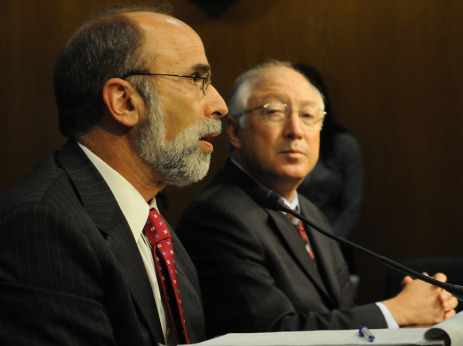 Newly appointed Bureau of Ocean Energy Director Michael Bromwich and Secretary of the Interior Ken Salazar testify before the Senate Interior Appropriations Subcommittee regarding reforms to strengthen offshore oil and gas oversight and enforcement.Photo and caption: U.S. Department of the InteriorIt’s a classic Washington paint job: new name, new leader, new promises about tossing bad apples. And so Minerals Management Services, the Interior Department agency that’s become the poster child of government corruption and ineptitude has been disappeared.
Newly appointed Bureau of Ocean Energy Director Michael Bromwich and Secretary of the Interior Ken Salazar testify before the Senate Interior Appropriations Subcommittee regarding reforms to strengthen offshore oil and gas oversight and enforcement.Photo and caption: U.S. Department of the InteriorIt’s a classic Washington paint job: new name, new leader, new promises about tossing bad apples. And so Minerals Management Services, the Interior Department agency that’s become the poster child of government corruption and ineptitude has been disappeared.
We now have the Bureau of Ocean Energy (BOE), with a fresh director — Michael Bromwich, a former inspector general in the Justice Department — and the promise of an internal investigative unit, a kind of “SWAT team” that would swing into action whenever corruption comes calling. But who, pray tell, will investigate the investigative unit?
We don’t do cozy: In his first week on the job, Bromwich endured the ritual Fed head baptism –a congressional hearing — and he used the occasion to reassure senators that MMS employees who wet their beaks in pools of Big Oil largesse have been sidelined. He also gave the evil eye to cozy relationships.
I hope and I think it is not pervasive across the agency. I hope it is limited to pockets of personnel, some of which are already gone, and the rest of which, if I have my say, will be gone soon. So there will be zero tolerance for corruption, coziness, et cetera.
It’s a twofer!: Not surprisingly, Congress is all over revamping the BOE and getting tougher on off-shore drilling. “Spill bills” are picking up steam in the Senate and the House and they have enough bipartisan support that Senate Majority Leader Harry Reid (D-Nev.) is seriously considering tying whatever climate legislation comes out of the Senate to one of them. As Coral Davenport and Darren Samuelsohn write in Politico:
The gamble: yoking a bipartisan, fast-track measure to overhaul offshore drilling rules with a broad, contentious bill capping greenhouse gas emissions that otherwise would have almost no chance of passage on its own.
The rig is up: Despite the recent action, the stink of the MMS legacy lingers. Interior Department chief Ken Salazar, back on Capitol Hill again, acknowledged that the agency formerly known as MMS was grossly understaffed when it came to people who could actually inspect oil rigs: 62 inspectors for almost 4,000 oil operations. Bad odds for sensitive ecosystems like the Gulf of Mexico.
Wear sunscreen, okay? Over in the House, members heard that not only were safety guidelines for oil rig workers voluntary, they had been drawn up in collaboration with the American Petroleum Institute. Greenwire’s Elana Schor had that story.
They got the fail part right: Meanwhile, the New York Times revealed that the MMS gave its blessing to blowout preventers on deepwater rigs being the ultimate failsafe devices. That major oops, according to the reporting team of David Barstow, Laura Dodd, James Glanz, Stephanie Saul, and Ian Urbina, gave government leaders, including Barack Obama, a false sense of security.
It also shows that the Obama administration failed to grapple with either the well-known weaknesses of blowout preventers or the sufficiency of the nation’s drilling regulations even as it made plans this spring to expand offshore oil exploration.
The pelicans will get the rest: And finally, a report from Neil King, Jr. and Keith Johnson, writing for the Wall Street Journal, that computer models provided to oil companies by the MMS greatly underestimated the threat of even large oil spills to Gulf marshes and beaches.
The government models, which oil companies are required to use but have not been updated since 2004, assumed that most of the oil would rapidly evaporate or get broken up by waves or weather. In the weeks since the Deepwater Horizon caught fire and sank, real life has proven these models, prepared by the Interior Department’s Mineral Management Service, wrong.
Say it ain’t so.




